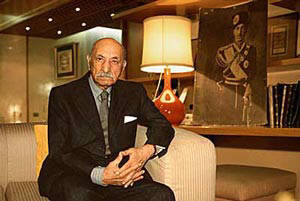Royal Afghanistan
Contents
The former Kingdom of Afghanistan
Source: Whitaker's Almanach 1969, pp. 816-817; Genealogical Gleanings. Afghanistan (Barakzai).
The late Father of the Nation, former King Zâhir Shah of Afghanistan. The photo is reproduced here by permission of the then Secretary of HM King Zahir Shah. Source: The Royal House of Afghanistan (former (?) official page). Article 156 of the Constitution of Afghanistan (2004) says: "The Title of the Father of the Nation and the privileges granted by the Emergency Loya Jirga of 1381 (2002) to His Majesty Mohammad Zahir Former King of Afghanistan are preserved for him during his lifetime, in accordance with the provisions of this Constitution." Source: Constitutional Commission Afghanistan Among the privileges were a permanent residence in the Presidential Palace and a ceremonial role.
News and facts about the Royal House
The former Islamic Emirate of AfghanistanOn 27 September 1996, the ruling members of the Afghan Government were displaced by members of the Islamic Taliban movement, cf. http://www.odci.gov/cia/publications/chiefs/chiefs0.html. The Taliban movement, which today has control of around 90% of the territory of Afghanistan, was formally declared as The Islamic Emirate of Afghanistan on 26 October 1997, cf. NTB (Norsk Telegrambyrå/Norwegian Telegraphic Agency) the same day. The leader of the Taliban movement, Mullah Mohammed Omar, was referred to as Emir al-Momineen ("Commander of the Faithful"). It should be stressed that the emirate was a religious one and cannot be compared with the seculiar Western monarchies.At Almanach de Bruxelles it is stated that Mullah Mohammed Omar was chosen as Emir already on 4 March 1996 and became de facto head of state in September 1997. The Taliban regime was not recognized by the international society. Originally Pakistan, Saudi Arabia and the United Arab Emirates had diplomatic connections with the regime, but these have been broken following the terror attacks on 11 September 2001. Updates: Following the United States' military action in Afghanistan, the Northern Alliance's troops made their entry into Kabul early on 13 November 2001 after the Taliban forces had left. The day after the Taliban city of Kadahar was about to fall, and former President Rabbiani was the same day expected to declare himself as the country's new leader and to "lead the provinces freed from the Taleban and also head the task of freeing provinces now under the control of the Islamist militia". By 14 November the Taliban had lost Kabul and other major cities and controlled less than 20% of the territory of Afghanistan, which means the emirate now could be described as abolished.
The Provisional Government 2001-2004Historical informationFollowing negotations in Bonn, a provisional Government headed by Mr. Hamid Karzai was inaugurated on 22 December 2001. The main points in the agreement reached in Bonn:
(Source: Aftenposten 6 December 2001.)
Legal information
Genealogy
Other information on Afghanistan
This page was last updated on Tuesday 16 February 2010 © 2001-2010 Dag Trygsland Hoelseth
|

